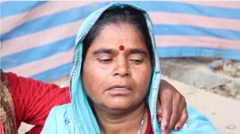In 2024, a dramatic rise in violent attacks has prompted questions about the root causes of growing frustration among the Chinese populace.
Rising Violence in China: Unpacking the Social Frustration Behind Mass Attacks

Rising Violence in China: Unpacking the Social Frustration Behind Mass Attacks
An analysis of the surge in mass killings in China highlights underlying economic and social tensions.
The string of mass killings in China this year has raised urgent concerns about societal pressures, with experts pointing to economic struggles and a lack of outlets for grievances as pivotal factors.
Widespread sorrow and anger have enveloped the nation, as devastating crimes perpetrated against strangers raise alarms about mental health and social stability. Notably, while violent incidents of this nature remain a rarity, their frequency has sharply increased, culminating in 19 reported cases so far in 2024—the lowest annual totals between three and five for previous years.
The wave began with tragic events, such as a horrific car attack in Zhuhai that claimed 35 lives when a disgruntled driver collided with pedestrians. Days later, a parent's rage over financial issues led to another attack near a primary school, injuring numerous children. Equally chilling was a stabbing spree by a university student, resulting in multiple fatalities.
As the rhetoric around these tragedies indicates, individuals commonly express their rage through random acts of violence, reflecting broader discontentment in a tightly controlled society struggling with economic woes. A firm understanding of contributing stressors reveals the actions of these individuals are steeped in frustration with an unforgiving economic landscape, soaring unemployment, and widespread disillusionment regarding personal prospects.
With the economy fluctuating, especially among young job seekers, many have found themselves trapped amid soaring debts and stagnant living conditions. Construction halts leave entire neighborhoods in limbo, with hopeful homeowners caught in empty shells of incomplete buildings.
A striking shift in public attitude underscores the growing pessimism regarding social mobility, and citizens are increasingly attributing societal inequalities to systemic unfairness rather than personal failures. This bleak perspective is compounded by increasing restrictions on free expression, rendering traditional outlets for grievances nearly inaccessible.
With the media operating under stringent government control, avenues to voice concerns are limited, pushing frustration to worse extremes. Additionally, mental health services remain woefully inadequate, failing to address the emotional turmoil plaguing many.
Experts assert that this amalgam of societal repression has created a pressure cooker environment. The consequences could be dire if these tensions remain unaddressed, prompting calls for bolstered mental health services as a preventive measure against escalating violence.
Authorities, particularly the Chinese government, have reacted with instinctive crackdowns rather than substantive reform, heightening public fears and exacerbating unrest. Despite recognizing the societal strain catalyzing these violent outbursts, current strategies have focused on increasing surveillance and police presence rather than reevaluating governance models.
As China enters a transformative period marked by unexpected violence and social unrest, observers are left to contemplate whether genuine attempts at addressing the populace's underlying grievances will begin to materialize or are instead slated for suppression beneath a veneer of control.
Widespread sorrow and anger have enveloped the nation, as devastating crimes perpetrated against strangers raise alarms about mental health and social stability. Notably, while violent incidents of this nature remain a rarity, their frequency has sharply increased, culminating in 19 reported cases so far in 2024—the lowest annual totals between three and five for previous years.
The wave began with tragic events, such as a horrific car attack in Zhuhai that claimed 35 lives when a disgruntled driver collided with pedestrians. Days later, a parent's rage over financial issues led to another attack near a primary school, injuring numerous children. Equally chilling was a stabbing spree by a university student, resulting in multiple fatalities.
As the rhetoric around these tragedies indicates, individuals commonly express their rage through random acts of violence, reflecting broader discontentment in a tightly controlled society struggling with economic woes. A firm understanding of contributing stressors reveals the actions of these individuals are steeped in frustration with an unforgiving economic landscape, soaring unemployment, and widespread disillusionment regarding personal prospects.
With the economy fluctuating, especially among young job seekers, many have found themselves trapped amid soaring debts and stagnant living conditions. Construction halts leave entire neighborhoods in limbo, with hopeful homeowners caught in empty shells of incomplete buildings.
A striking shift in public attitude underscores the growing pessimism regarding social mobility, and citizens are increasingly attributing societal inequalities to systemic unfairness rather than personal failures. This bleak perspective is compounded by increasing restrictions on free expression, rendering traditional outlets for grievances nearly inaccessible.
With the media operating under stringent government control, avenues to voice concerns are limited, pushing frustration to worse extremes. Additionally, mental health services remain woefully inadequate, failing to address the emotional turmoil plaguing many.
Experts assert that this amalgam of societal repression has created a pressure cooker environment. The consequences could be dire if these tensions remain unaddressed, prompting calls for bolstered mental health services as a preventive measure against escalating violence.
Authorities, particularly the Chinese government, have reacted with instinctive crackdowns rather than substantive reform, heightening public fears and exacerbating unrest. Despite recognizing the societal strain catalyzing these violent outbursts, current strategies have focused on increasing surveillance and police presence rather than reevaluating governance models.
As China enters a transformative period marked by unexpected violence and social unrest, observers are left to contemplate whether genuine attempts at addressing the populace's underlying grievances will begin to materialize or are instead slated for suppression beneath a veneer of control.






















